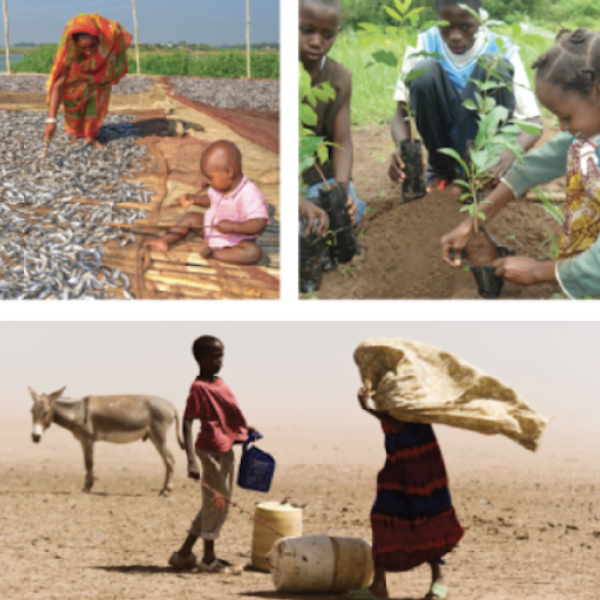Climate Finance
Additional finance is needed across all sectors to address climate change impacts. Catalyzing additional public and private investments can promote climate adaptation and resilience.
The Economic Impacts of Climate Change
Climate change is already affecting poverty, economic growth, health, peace and stability, and migration and displacement. In the face of these impacts, we require substantial adaptation investments to maintain and advance development goals.. The physical and economic costs of climate change are borne disproportionately by poor communities.
Estimates indicate that annual climate adaptation costs in developing countries could reach $300 billion by 2030 and as much as $500 billion by 2050. It is clear that additional resources are needed across all sectors and at all levels to fund climate adaptation and address the risks of our changing climate. Large capital investments and the creative use of financial tools are necessary to promote and protect resilience, especially for women, youth and other marginalized groups who already face barriers accessing finance.
How Can Increased Funding Promote Resilience?
Catalyzing public and private investments can promote climate adaptation and resilience. An increased focus on and investment in climate adaptation and resilience measures will support:
- Climate-smart agriculture
- Sustainable water and sanitation services
- Health and education services
- Resilient infrastructure
- Early warning systems
- Assistance to populations after climate shocks
- Ecosystem protection and nature-based solutions
- Increased inclusive economic productivity and opportunity
- Transformative shifts to climate-resilient pathways
USAID's Commitments to Fund Climate Adaptation
USAID has announced that it will mobilize $150 billion in public and private finance for climate adaptation and mitigation measures by 2030. Increasing and scaling climate finance tools can create a virtuous cycle of economic benefits for those most affected by climate change by bringing finance to geographies, sectors, populations and communities historically unable to access it. Learn more about USAID’s efforts to unlock private sector resources to address climate change.
USAID’s Climate Strategy will guide the Agency’s efforts through 2030 to advance equitable and ambitious actions to confront the climate crisis. Under the Climate Strategy, USAID has committed to providing and mobilizing finance to support climate actions for adaptation and mitigation.
USAID's Commitment to Fund Climate Adaptation
As part of this effort, USAID will:
- Bring finance to geographies, sectors, populations and communities vulnerable to climate impacts through efforts that convene and catalyze impactful private and public finance
- Employ blended finance, loan guarantees and insurance, among other tools, to mobilize climate finance
- Enhance the ability of entrepreneurs and partners to seek financing and access helpful tools
- Mobilize domestic resources, both public and private, through partnerships
- Support inclusive approaches and access to climate finance, including locally led innovations
- Leverage locally led development to ensure local priorities and needs are met
- Ensure transparent and accountable governance of investments
USAID’s approach to reduce greenhouse gas emissions, help partner countries build resilience and improve its own operations.
How is Climate Finance Used?
Blended finance, the strategic use of public resources to attract private capital, can dramatically increase the scale and scope of climate finance in the coming years. Blended finance combines donor funding and private capital to reduce risks and increase opportunities for private investors while generating positive development outcomes. An estimated $31 billion for climate-focused investments has been channeled through blended finance models to date. Most blended finance has gone toward mitigation efforts; however, there have increasingly been calls to commit additional funding toward adaptation.
Unlocking and catalyzing private sector funding through blended finance is a critical first step in promoting adaptation and resilience. But how can this funding be used?
Disaster Risk Insurance
Climate risk finance tools, including insurance, can promote resilience by reducing vulnerabilities to climate risks. These tools provide a critical safety net, protecting assets, lives and livelihoods from the impact of climate disasters. Research into disaster risk financing suggests that increased insurance coverage could reduce losses in the poorest countries by as much as 25%.
Locally Led Adaptation
As both public and private investments in adaptation and resilience increase, locally led adaptation may help ensure that investments meet local priorities and needs. Locally led adaptation is a core principle of USAID’s Climate Strategy, and requires finance and decision-making processes that:
- Prioritize local actors who are often best placed to identify adaptation solutions
- Support transparency, accountability and equitable resource mobilization
More About Climate Finance
UN Climate Change Conference (COP28)
30 Nov 2023, GMT +4 - United Nations Climate Change
Engage with climate change leaders around the world to align efforts on climate action and assess progress since adopting the Paris Agreement.
Resilience Evidence Forum 2023 Synthesis Report
19 Sep 2023 - USAID , Global Resilience Partnership
Explore key discussions held at the June 2023 Resilience Evidence Forum in this comprehensive guide to resilience-building methodologies and evidence.
Financing Adaptive Social Protection for Drought in Malawi to Protect the Vulnerable
25 Jul 2023, GMT -4 - ResilienceLinks , USAID , World Bank Group
Learn how Malawi used disaster risk financing to support their adaptive social protection efforts.
Technical Analysis to Inform the Trigger Design for Adaptive Safety Nets to Respond to Climate Shocks in Malawi
23 Jun 2023 - World Bank Group , Richard Choularton , Agrotosh Mookerjee , Meredith Mallory , Krishna Krishnamurthy , Rahel Diro , Evie Calcutt , Alejandra Campero
Discover how the Government of Malawi designed a scalable trigger mechanism to provide social protection during climate shocks.





